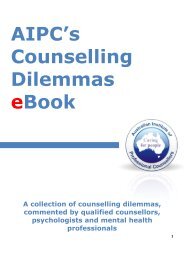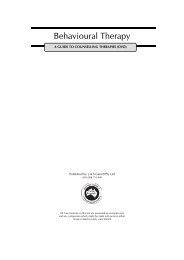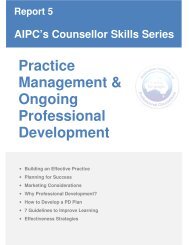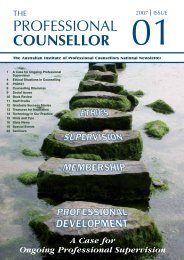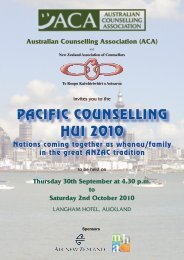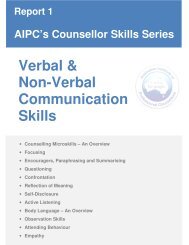Why Diversity? - Counselling Connection
Why Diversity? - Counselling Connection
Why Diversity? - Counselling Connection
- No tags were found...
You also want an ePaper? Increase the reach of your titles
YUMPU automatically turns print PDFs into web optimized ePapers that Google loves.
AIPC’s Counsellor Skills Series, Report 3Some children may be fearful about coming to counselling and may not want to participate inthe session. One way of overcoming this barrier is to give the child the counsellor role.Children feel very excited to be in the driver’s seat.An example of this technique would be: James is six and his mother brings him tocounselling because he has behaviour problems. James’s behaviour became worse after hismum and dad separated. The counsellor, who was the client for the session, began to talkand draw pictures of her duck (Queenie) and about all the things as a little girl they didtogether. The counsellor (client) then discussed about how sad she felt when Queenie diedbecause she was her only support when her mummy went to work.She went on to say “that when her mummy went to work she was very fearful that she wouldnot come home”. James listening to this, said “yes me too”. “I am so scared when myMummy goes to work that she will leave me and never come home”. He then began to drawpictures of his guinea pigs and express how he felt when they died. The session concludedwith James happy to come back and play the role of the counsellor. This is a usefultechnique and can be very helpful when there are barriers blocking children from expressingtheir feelings.Below we discuss a couple of other techniques that can be used to assist children:Five Feelings Cards - One simple technique is the five feelings technique. There are fiveimportant feelings that children are likely to have: SAD, MAD, HAPPY, SCARED andLONELY. These feelings are written on five cards and whilst holding up the cards andproceeding through the five of them, the counsellor could ask the child to pick the card thatmatches how they feel (Jarratt, 1982).The Feeling Chart - The feeling chart can also be used where children pick how they arefeeling and put it in the middle of the chart. Then the child can draw the face to go with thefeeling. Sometimes other emotions may need to be added to the basic list such as silly,angry, sleepy, sick, surprised, embarrassed feelings and helpless feelings.Five Faces Technique (Jarratt, 1982)Source: Jarratt, C.J. (1982). Helping children cope with separation and loss (Rev. ed.).Boston, MA: The Harvard Common Press.Another effective way for counsellors to work with children about their feelings is to use anactivity that combines seeing, hearing and doing and alternates feelings with other activities -for example, putting a face to how they are feeling.Feeling faces cards are a good way to begin talking about some of the things that might betroubling children. Spreading the cards on the table the counsellor might ask the child whichof these feelings they had when their mum didn’t live with their dad anymore; or indirectlyask the child what they might say to someone about how kids might feel when they don’t livewith one of their parents anymore. The child can then use the cards to explore and explainthe feelings about the same event.The counsellor could start by telling the child that she knows of at least five feelings that kidsare likely to have. Then ask the child if they would know what some of them might be. Thedialogue would go like this.Page 14



